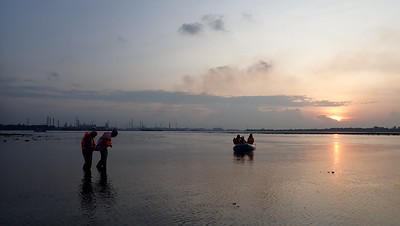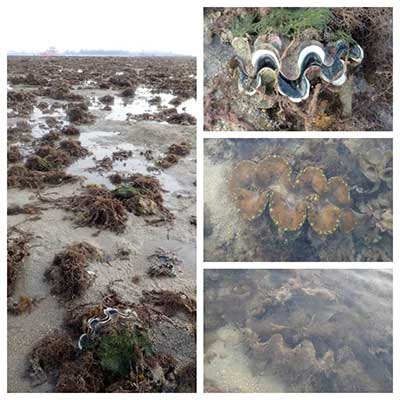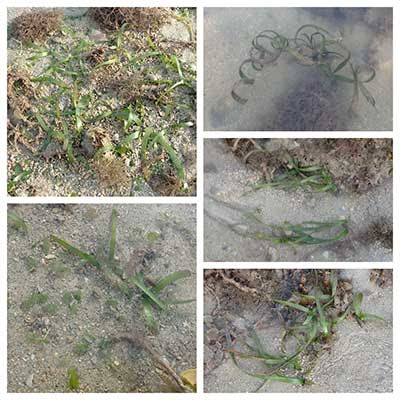While the small reefy patch on this shore seemed to have declined, we saw two live Giant clams and there were signs of good seagrass growth. The team also saw seahorse, shark and other interesting marine life. And our skipper saw six sea turtles.
There is a small area here that was densely covered with hard corals. Today, I didn't see as many live corals as on our last survey in May 2021. I sense many of the large corals at the reef edge were dead and covered with algae. I'm not really sure what happened.
But I still saw a good variety of hard corals. From commonly seen ones to those which are seldom seen on our shores. They come in all kinds of shapes and textures. Most I saw were alright.
I also saw many small to medium sized colonies of leathery soft corals of various kinds. And many large colonies of Asparagus flowery soft coral. Those I saw were all alright.
I saw two live Fluted giant clams. One near the reef edge, probably the same one Russel shared from our survey on May 2021. I also saw the empty shell of a much larger one nearby.I saw another live one on the shore facing Sudong. Both clams were about 40cm long. Kelvin went to find the ones he saw on a previous survey and could only find the empty shells of one of them.
Thanks to Kelvin for this awesome side by side photo comparison of the Giant clam that died. RIP.
A shark suddenly appeared among us as we carefully explored the reefy edge. Yong Jen took this great shot of it before it swam away.
Juria filmed this 'Nat Geo moment' of a Common hairy crab dragging a seahare into its burrow. The seahare was inking throughout. We are not sure how the crab can eat something so many times larger than itself!
We came across many nudibranchs today gathered close to one another. I saw many Jorunna nudibranchs and one pair that were lined up and appeared to be exchanging sperm. Nudibranch are hemaphrodites and each animal has both male and female parts. I also saw a Halloween flatworm, and a small Fire anemone.
All these animals belong to the same larger grouping of Echinoderms! I saw the skeleton of a Keeled heart urchin, two Kumquat sea cucumbers and one Big synaptid sea cucumber.
The seagrass situation seems slightly improved compared to our last survey in May 2021. I saw several clumps of Tape seagrass with longish leaves, some very curly. I didn't see any that were cropped short. There were also sprinkles Spoon seagrasses, and some Sickle seagrasses.Near the reef edge, a pool of bare sand is probably the result of a boat striking the submerged reef at higher tide.
Terumbu Bemban is the western most submerged reef just before the Life Firing Islands. From here, we can see Pulau Bukom. The area nearby is now also used for a lot of ship anchoring.

Future of Terumbu Bemban
Although not directly slated for reclamation, large areas nearby are among the existing natural shores that may be impacted by the landuse plan by the Ministry of National Development released in Jan 2013 in response to the Population White Paper with a 6.9 million population target. The dotted margined blue areas are "Possible Future Reclamation".

The Singapore Blue Plan 2018
Pulau Semakau and nearby islands and submerged reefs have been recommended by the Singapore Blue Plan 2018 for Immediate Conservation Priority.
The Blue Plan recommends the intertidal and subtidal marine areas of Pulau Semakau and adjacent Pulau Hantu, and Pulau Jong to be designated Marine Reserve.
The Blue Plan highlights that Pulau Semakau and its associated patch reefs comprise many ecosystems: coral reefs, mangrove areas, intertidal sandflats, seagrass meadows, and coral reefs. The subtidal area of Pulau Jong is larger than the terrestrial area. Pulau Hantu is a popular dive site has seen increasing interest in the past decade due to biodiversity awareness. If protection is accorded to these three islands, zonation plans for use can be implemented to manage tourism and human impacts.
DOWNLOAD the Plan, SUPPORT the Plan! More on the Singapore Blue Plan 2018 site.
Photos by others on this survey
Jonathan Tan
Tang Yong Jen
Benny Cheong
Kelvin Yong
Marcus Ng
Juria Toramae
Che Cheng Neo
Richard Kuah
On the same day, Jianlin Liu surveyed Changi










